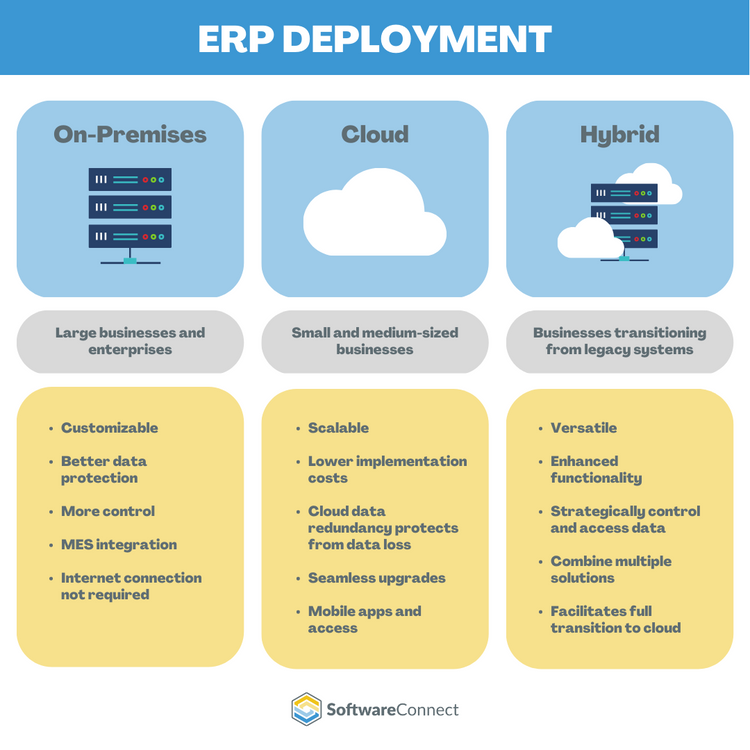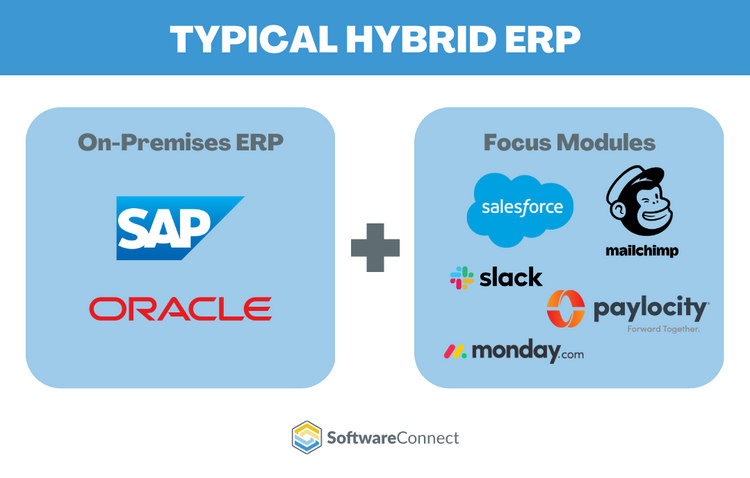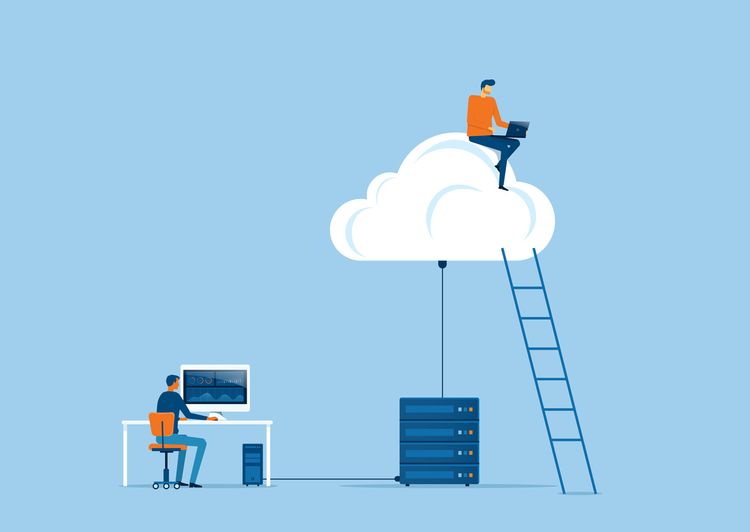What is Hybrid ERP?
You don’t have to choose between keeping your on-premise enterprise resource planning solution or implementing a new cloud-based one: A hybrid ERP combines on-premises ERP and cloud-based software, creating a solution that is the best of both worlds.
Hybrid ERP Explained

A typical hybrid ERP is when a company uses a combination of both on-premise ERP and cloud-based modules to conduct separate business operations.
Companies often adopt the hybrid ERP system when they already have a legacy on-premise solution but want to expand functionality with the cloud. Sometimes, this is a permanent solution; sometimes, it’s a transitional step to test the waters of moving their ERP entirely to the cloud.
In a typical hybrid ERP deployment, an on-premise ERP (i.e. SAP, Oracle, etc.) is used for corporate functions, and cloud-based focused modules help manage specific business units. These modules and collaboration tools include:
- Customer Relationship Management (CRM): Salesforce, Zoho CRM
- Project Management: Notion, Monday.com
- Workforce Management: BambooHR, Paylocity
- Email Marketing: MailChimp, SendGrid
- Collaboration Tools: Microsoft Teams, Slack

On-Premises ERP
On-premises ERP systems are installed locally on your company’s servers.
Larger businesses and enterprises typically use on-premise solutions since they have the resources and physical space to maintain this system in a data center. Businesses using this deployment method prefer it for the control it grants them over data storage and software running.
ERP implementation takes substantial time and financial investment, and the additional maintenance requires specialized IT staff. Also, scaling the software is more challenging than scaling it with cloud-based ERP.
Cloud-Based ERP
Cloud ERP is software accessible through a web browser that has an internet connection. The ERP supplier stores user data on a centralized server and grants users access to the data through the cloud.
Cloud ERPs usually follow the Software-as-a-Service (SaaS) model, so companies pay through a subscription. Since suppliers manage cloud systems, they automatically implement upgrades. Also, unlike on-premise solutions, system maintenance typically doesn’t require dedicated IT staff.
The integration process for cloud ERP solutions generally requires less time and financial investment. In addition, cloud systems are typically more user-friendly than on-premise solutions, and many offer mobile apps and access.
Cloud providers are quick to add new features, such as those for e-commerce and social media. These kinds of tools are necessary for an evolving digital business landscape, but not feasible in an on-premise system.

Advantages of a Hybrid ERP System
-
Easy Upgrade: Many companies adopted on-premise ERP systems when they were first considered top-of-the-line solutions. Now, these same solutions are overshadowed by the innovation of cloud computing. Adding cloud modules is an easy way to upgrade your system and respond to business needs without significant on-premises software changes. Cloud providers easily distribute software updates to help your company remain competitive.
-
Lower Cost: Deploying an on-premise solution in all your departments or expanding your existing system to new locations can be too expensive. However, the hybrid method is cost-effective for increasing your ERP’s functionality.
-
Scalability: Hybrid ERPs offer a cost-effective and time-efficient solution for growing businesses. Expanding functionality by adding cloud modules minimizes the risk of compromising the integrity of your existing on-premise ERP.
-
Regulatory Flexibility: Throughout a single company, data from different departments can be subject to individual reporting and security regulations. Hybrid solutions allow companies to use specific solutions that help maintain regulatory compliance. Also, cloud-based solutions typically update quickly to ensure data collection and reporting comply with constantly changing government regulations.
-
Test The Cloud: Transitioning from an on-premise system can be costly and time-consuming, and onboarding your team with a new system can be challenging. Many companies see the benefits of moving to a full-cloud-based ERP but want to test the waters before diving in.
-
Meet Industry and Regional Needs: Different industries and geographical regions have their own specific requirements. For example, industry needs can include special business service tools, and regional needs might include language and local tax requirements. Implementing specialized cloud software can help meet these business needs without complicating an already complex on-premise system.
-
Build The Best System: Choosing the hybrid method allows your business to combine best-in-class applications (on-premise ERP) with best-of-breed applications (cloud modules) to build a system that optimizes business performance and improves productivity and profitability.
FAQ
Why should I choose a hybrid ERP for my business?
A hybrid ERP system is the best solution for companies that want to upgrade their legacy on-premise ERP, transition to the cloud, or build a best-in-class system from the ground up.
Are there any disadvantages of a hybrid ERP?
Implementing the hybrid model means you will have separate on-premise and cloud-based solutions that may or may not integrate. Instead of one database that stores the entire company’s ERP data, you could have separate databases with each solution. For those interested in the most integrated option, a hybrid ERP poses this disadvantage.
What is the difference between a hybrid ERP and a two-tier ERP?
A hybrid ERP combines on-premises and cloud software to form a single system. A hybrid system comprises either an on-premise ERP and a cloud-based ERP, or an on-premise ERP and cloud-based modules.
In a two-tier ERP system, a large company with smaller subsidiaries uses two or more separate ERP solutions. These companies will typically use a more customized ERP for the headquarters (tier 1) and a less resource-intensive ERP for the subsidiaries (tier 2). Any combination of on-premises and cloud-based ERPs can make up a two-tier system.
Read More: The 3 Tiers of ERP Explained: Definition and Examples
